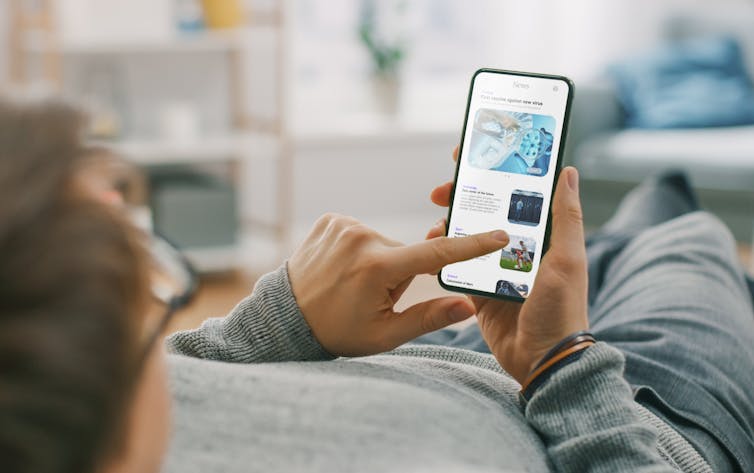Opinion: COVID-19 - The first study to look at whether fake news actually changes people’s behaviour
Posted 30 June, 2021

“The spread of COVID-19 is linked to (opens in a new window)5G mobile networks.” “Place a (opens in a new window)halved onion in the corner of your room to catch the COVID-19 germs.” “(opens in a new window)Sunny weather protects you from COVID-19.”
These fake news stories and others like them spread rapidly on social media during the early stages of the pandemic. The wave of misinformation was so great that the authorities coined a word for it: (opens in a new window)“infodemic”.
Fake news isn’t new. But interest in it has (opens in a new window)increased sharply in recent years, corresponding with the rise of social media. Attention spiked in 2016, amid concerns that the (opens in a new window)Brexit referendum and the (opens in a new window)US presidential election may have been influenced by misinformation spread by other countries.
It’s assumed that fake news has a negative effect on people’s behaviour. For example, it has been claimed that fake news might affect people’s willingness to (opens in a new window)wear a mask, (opens in a new window)get a vaccine or (opens in a new window)comply with other public health guidelines. Yet, surprisingly, virtually no research has directly tested this assumption, so my colleagues and I took on the challenge of measuring what effect fake news actually has on people’s behaviour.
In May 2020, we recruited over 4,500 participants to an online study via an article on the Irish news website (opens in a new window)TheJournal.ie. Participants were told that the purpose of the study was to “investigate reactions to a range of public health messages and news stories relating to the novel coronavirus outbreak”.
 Eating chilli peppers or other spicy foods will not protect you from COVID. (opens in a new window)lunamarina/Shutterstock
Eating chilli peppers or other spicy foods will not protect you from COVID. (opens in a new window)lunamarina/Shutterstock
Each person was shown four true news stories about the pandemic and two fake news stories (selected from a list of four fake stories). These fake articles were designed to be very similar to those circulating at the time. They stated that drinking coffee might protect against the coronavirus, that eating chilli peppers might reduce COVID-19 symptoms, that pharmaceutical companies were hiding harmful side-effects of a vaccine then in development, and that the forthcoming contact-tracing app to be released by Ireland’s public health service had been developed by people with ties to (opens in a new window)Cambridge Analytica.
After reading the stories, the participants indicated how likely they were to act on the information over the next several months, such as drinking more coffee or downloading the contact-tracing app.
(opens in a new window)We found that fake stories did seem to change people’s behaviour, but not dramatically so. For example, people who were shown the fake story about privacy concerns with the contact-tracing app were 5% less willing to download the contact-tracing app than those who hadn’t read this story.
Some participants even developed false memories about the fake stories they had read (which we had also seen happen in some of our (opens in a new window)previous research). “Remembering” previously hearing a fake COVID-19 story seemed to make some people in our study more like to act in a certain way. For example, people who falsely remembered hearing about the contact-tracing app’s privacy issues were 7% less likely to download the contact-tracing app than those who read the story but didn’t “remember” it.
Such effects were small and they didn’t happen with every fake story. But even small effects can produce big changes. Unfounded concerns about a link between the MMR vaccine and autism led to a relatively small (opens in a new window)drop in childhood vaccination rates in the early 2000s – about 10% – which in turn led to a significant spike in measles cases. So it’s possible that the small effects of fake news we saw in our study could have bigger effects on people’s health.
 Those who ‘remembered’ seeing the fake story about coffee intended to drink more in future compared to those who saw the story but didn’t ‘remember’ it. (opens in a new window)auns85/Shutterstock
Those who ‘remembered’ seeing the fake story about coffee intended to drink more in future compared to those who saw the story but didn’t ‘remember’ it. (opens in a new window)auns85/Shutterstock
However, there are some important points to consider. First, we measured people’s intentions to do things, not what they actually did. Intentions (opens in a new window)don’t always (opens in a new window)translate into actions – consider, for example, your past plans to eat more healthily or exercise more. However, if people don’t even intend to change their behaviour, the chances of them actually doing so are slim, so measuring intentions is an important first step.
Second, our study was based on people reading new made-up stories just once. In the real world, people may come across fake news stories many times on social media. Being repeatedly exposed to the same story can (opens in a new window)increase how true it seems. The effects of repeatedly seeing fake news stories therefore needs further investigation.
Warnings had little effect
A secondary aim of our study was to look the effects of general warnings about misinformation, such as those shared by (opens in a new window)governments and (opens in a new window)media organisations. These warnings typically encourage people to think critically about online information and think before they share.
Again, there hasn’t been a lot of research on this topic. We were aware of only (opens in a new window)one study that had looked at whether these sorts of generic warnings have an effect on whether people accept misinformation. Crucially, people in that study were aware that they were taking part in research on fake news, which might have made them more suspicious of what they were viewing.
In our research, some participants were randomly made to read a generic misinformation warning before then reading the true and fake stories. Surprisingly, we found that reading a warning had no effect on people’s responses to the fake stories. Governments should think about this when considering their fake news strategies: while the effect of fake news may be less than expected, the effect of any warning could also be low.
By (opens in a new window)Ciara Greene, Associate Professor of Psychology, (opens in a new window)University College Dublin
This article is republished from (opens in a new window)The Conversation under a Creative Commons license. Read the (opens in a new window)original article.
![]()






